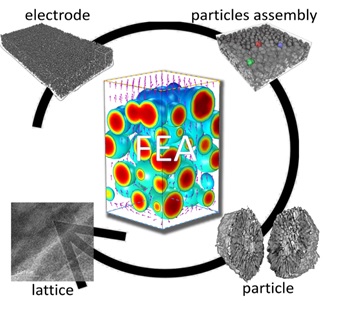The rapidly growing market for consumer electronics and electric vehicles has motivated tremendous research efforts in rechargeable batteries. An important aspect of the battery research is to identify the fading pathways of battery particles and electrodes upon prolonged operation. These complicated processes, intertwined at multiple length and time scales, are termed as the chemomechanical interplay. The multiscale chemomechanical interplay builds up mechanical stress, provokes morphological breakdown, and leads to states of charge heterogeneity in lithium ion batteries.

Quantifying the interplay in complex composite electrodes with multiscale resolution constitutes a frontier challenge in precisely diagnosing the fading mechanism of batteries. A joint research team led by Dr. Yijin Liu (SSRL), Dr. Kejie Zhao (Purdue), Dr. Feng Lin (Virginia Tech) and Dr. Yang Yang (ESRF) has tackled this challenge by combing the techniques of transmission x-ray microscopy, nanoscale hard x-ray spectro-microscopy, hard x-ray phase contrast nano-tomography, soft x-ray absorption spectroscopy (XAS), and transmission electron microscopy (TEM) to systematically investigate the morphological and chemical degradation in polycrystalline nickel-rich layered NMC composite electrode under fast charging conditions.
They successfully visualized and quantified the degree of local damage in the composite electrode that is hierarchically complex. In particular, hard x-ray phase contrast tomography, capable of nano-probing thousands of active particles at once, enables an unprecedented statistical analysis of the chemomechanical transformation of secondary battery particles under fast charging conditions. This quantitative visualization allowed them to extract the depth-dependent trend of particle fracturing within the electrode as well as its lateral complexity. The results suggest that the active particles within the electrode contribute to the cell level chemistry differently in time and position. They concluded, based on the degradation depth profile, that initially more damage takes place near the separator, evolving to a more homogeneous distribution as particles located deeper in the electrode take over the electrochemical activities in later cycles. Finally, finite element modeling (FEM) with shape models recovered from the nano-tomography data was also adopted to gain insights into the electrode level strain distribution and evolution. They point out that the damage heterogeneity has been demonstrated to prevail at all length scales, which causes unbalanced local electrical and ionic conductivity, and collectively leads to the non-uniform utilization of active particles spatially and temporally.
These findings features the statistical mapping of the chemomechanical transformation in the composite electrode, which offers a diagnostic method for probing and understanding the non-uniform particles utilization and fading. Thus they anticipate that the developed methodology and understanding will pave the way towards improved electrode formulation for fast-charging batteries. They published their results in two back-to-back papers in Advanced Energy Materials and Journal of the Mechanics and Physics of Solids.
Y. Yang, R. Xu, K. Zhang, S.-J. Lee, L. Mu, P. Liu, C. K. Waters, S. Spence, Z. Xu, C. Wei, D. J. Kautz, Q. Yuan, Y. Dong, Y.-S. Yu, X. Xiao, H.-K. Lee, P. Pianetta, P. Cloetens, J. Lee, K. Zhao, F. Lin and Y. Liu, "Quantification of Heterogeneous Degradation in Li-Ion Batteries", Adv. Eng. Mater. 1900674 (2019) doi: 10.1002/aenm.201900674
R. Xu, Y. Yang, F. Yin, P. Liu, P. Cloetens, Y. Liu, F. Lin and K. Zhao, "Heterogeneous Damage in Li-ion Batteries: Experimental Analysis and Theoretical Modeling", J. Mech. Phys. Sol. 129, 160 (2019) doi: 10.1016/j.jmps.2019.05.003




